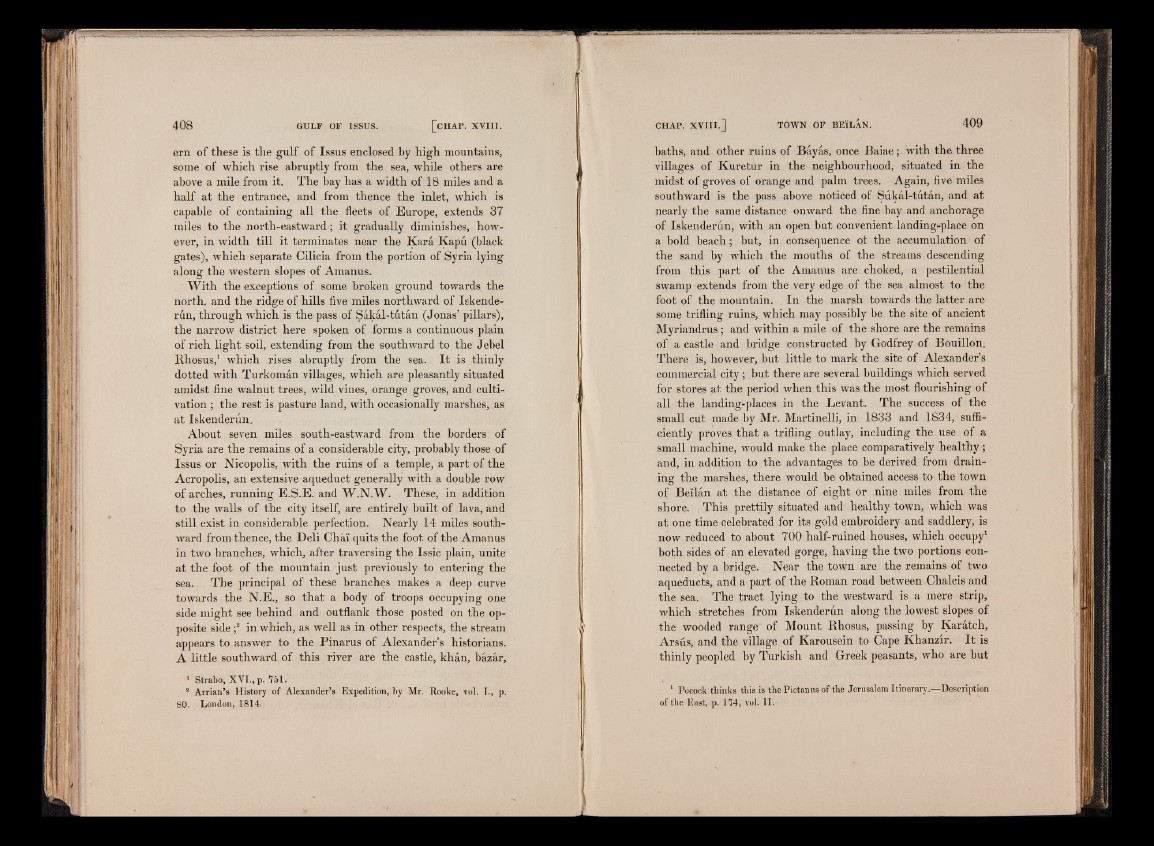
ern of these is the gulf of Issus enclosed by high mountains,
some of which rise abruptly from the sea, while others are
above a mile from it. The bay has a width of 18 miles and a
half at the entrance, and from thence the inlet, which is
capable of containing all the fleets of Europe, extends 37
miles to the north-eastward-; it gradually diminishes, however,
in width till it terminates near the Kara Kapu (black
gates), which separate Cilicia from the portion of Syria lying
along the western slopes of Amanus.
With the exceptions of some broken ground towards the
north, and the ridge of hills five miles northward of Iskenderun,
through which is the pass of Sàkàl-tutàn (Jonas’ pillars),
the narrow district here spoken of forms a continuous plain
of rich light soil, extending from the southward to the Jebel
Rhosus,1 which rises abruptly from the sea. It is thinly
dotted with Turkoman villages, which are pleasantly situated
amidst fine walnut trees, wild vines, orange groves, and cultivation
; the rest is pasture land, with occasionally marshes, as
at Iskenderun.
About seven miles south-eastward from the borders of
Syria are the remains of a considerable city, probably those of
Issus or Nicopolis, with the ruins of a temple, a part of the
Acropolis, an extensive aqueduct generally with a double row
of arches, running E.S.E. and W.N.W. These, in addition
to the walls of the city itself, are entirely built of lava, and
still exist in considerable perfection. Nearly 14 miles southward
from thence, the Deli Chài quits the foot of the Amanus
in two branches, which, after traversing the Issic plain, unite
at the foot of the mountain just previously to entering the
sea. The principal of these branches makes a deep curve
towards the N.E., so that a body of troops occupying one
side might see behind and outflank those posted on the opposite
side f in which, as well as in other respects, the stream
appears to answer to the Pinarus of Alexander’s historians.
A little southward of this river are the castle, khan, bazàr,
1 Strabo, XVI., p. lò l .
s Arrian’s History of Alexander’s Expedition, by Mr. Rooke, vol. I., p.
80. London, 1814.
baths, and other ruins of Bayas, once Baiae; with the three
villages of Kuretur in the neighbourhood, situated in the
midst of groves of orange and palm trees. Again, five miles
southward is the pass above noticed of Sukal-tiitan, and at
nearly the same distance onward the fine bay and anchorage
of Iskenderun, with an open but convenient landing-place on
a bold beach; but, in consequence of the accumulation of
the sand by which the mouths of the streams descending
from this part of the Amanus are choked, a pestilential
swamp extends from the very edge of the sea almost to the
foot of the mountain. In the marsh towards the latter are
some trifling ruins, which may possibly be the site of ancient
Myriandrus; and within a mile of the shore are the remains
of a castle and bridge constructed by Godfrey of Bouillon.
There is, however, but little to mark the site of Alexander’s
commercial city; but there are several buildings which served
for stores at the period when this was the most flourishing of
all the landing-places in the Levant. The success of the
small cut made by Mr. Martinelli, in 1833 and 1834, sufficiently
proves that a trifling outlay, including the use of a
small machine, would make the place comparatively healthy;
and, in addition to the advantages to be derived from draining
the marshes, there would be obtained access to the town
of Bei'lan at the distance of eight or nine miles from the
shore. This prettily situated and healthy town, which was
at one time celebrated for its gold embroidery and saddlery, is
now reduced to about 700 half-ruined houses, which occupy1
both sides of an elevated gorge, having the two portions connected
by a bridge. Near the town are the remains of two
aqueducts, and a part of the Roman road between Chalcis and
the sea. The tract lying to the westward is a mere strip,
which stretches from Iskenderun along the lowest slopes of
the wooded range of Mount Rhosus, passing by Karatch,
Arsus, and the village of Karousein to Cape Khanzir. It is
thinly peopled by Turkish and Greek peasants, who are but
1 Pocock thinks this is the Pictanus of the Jerusalem Itinerary.—Description
of the East, p. 114, vol. II.